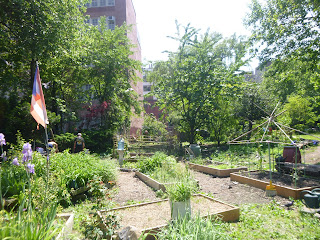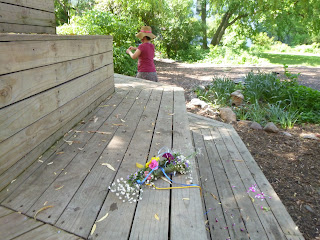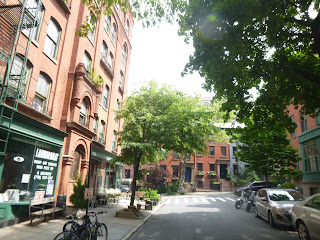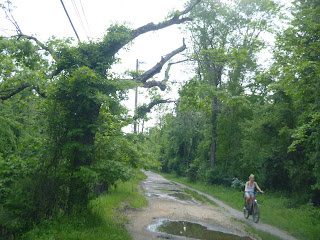 Road Trip with Tim and Mel, October 2019.
Road Trip with Tim and Mel, October 2019. I think about Tim as part of my first month club, the people I met my first month in NYC in 1997, going to SexPanic! meetings, someone who was there for Matthew Shepard protests of 1998 and garden protests and immigration protests and trump protests for 25 years as movements ebbed and flowed through our lives. The years of friendship, laughing about the sex and activism, our collective flaws, Tim wanting to knock all the books off the bookshelf in Susan Collins' office. I think about it all now.
I had three distinct periods of friendship with Tim, the late 1990’s with ACT demos, speaking out against homophobia and the two decades of activism that grew out of that, the Trump Years, when we drove to and from DC to fight for the Affordable Care ACT, under attack from Republicans, fighting the GOP tax scam, taking bust after bust for civil rights, and talking about it all along the way. The COVID years followed this somewhat golden era of friendship, with Tim’s illness taking increasing intensity; isolation following, before he eventually departed. By far the happiest time of our friendship took place on those trips to and from DC, the demos he was a legal aid for when we were getting arrested, when he articulated an urgent need to save healthcare for everyone. For a while there, I talked with Tim every day, chatting about actions coming up, greeting him at Rise and Resist demos, etc. When he joined us in the car to DC to fight for the Affordable Care Act, Tim held court with the other activists, chatting with Austin, my cycling comrad, all the way to DC, laughing all the way, even when he left his glasses behind, probably crumbled in the parking lot, he lamented with a smile and a giggle. We talked about his life in New York and Columbus, Georgia, my Mom’s home town, as we sat in the bus on the way to fight the Kavanaugh appointment to the Supreme Court. We got arrested together on that one, cheering and celebrating when we got out, chatting about ACT UP and sex and needing to get away from the bigots of our Southern childhoods all the way home. In DC, Tim made common cause with disability rights activists and immigrant advocates fighting for the Deferred Action for Childhood Arrivals. On the stories continued to and from demos, meetings, court dates, etc.
A blog entry from October 2019, when Mel, Tim, and I went to DC to pay our fines after an arrest at the Supreme Court captures some of the feel of those conversations and Tim’s history as an activist:
Timothy plays Together in Electric Dreams, asking Ben to listen to the words:
I never saw your smile'til it was time to go
Time to go away (time to go away)Sometimes it's hard to recognize
Too late to stay (Love never ends)We'll always be together
However far it seems(Love never ends)We'll always be together
Together in electric dreams Because the friendship that you gave”
As he told Sarah Schulman in the ACT UP oral history project Interview 7 April 28, 2010:
Tim and Mel came over for movies on New Years day, January 2020, chuckling away, irreverently laughing at it all.
We talked about bromance, adoring catching up at Rise and Resist or World AIDS Day demos, uptown, downtown, Staten Island, and Washington Square Park, Reclaim Pride with Mel pushing his wheelchair, all day long, or a Virgina and Andrew’s summer BBQ in the park in June 2019.
Tim always had health issues he was grappling with, a broken this or that, a fall on the stairs on the subway that left his arm broken, unable to hear. It just wouldn’t heal. As the years went on, they became more serious. And his health deteriorated. I didn’t see him much once COVID exploded. His speech was barely audible at Larry Kramer’s memorial, two years ago. But the point was real. We were all in the struggle together, fighting AIDS and ALS and cancer for each other and for the community. By the time we reconnected in the Spring of 2021, Tim was bedridden in his tiny West Village, New York apartment.
We had a few video conferences that summer. The mystery of Tim’s eroding health was solved. He had been diagnosed with ALS otherwise known as Lou Gehrig's Disease. It was like HIV in the early days, a death sentence. Life expectancy after diagnosis was around two to five years. Not good. To date, there is no cure to stop or reverse the progression as muscles lose control.
On one call, Tim cried and cried, more than aware of what was happening. Mel caressed Tim. But I knew this was a stress on him as well.
Fully vaccinated Mel said I could drop by. The visits became weekly or biweekly to their West Village apartment. There we chatted about old ACT UP friends, who disappeared with his old issues a Steam, a public sex journal, we loved, broadway show tunes, Barbara Streissand, the nature of poetry, Walt Whitman, leaves of grass, what being friends was all about. The reality was he was the closest of friends. He always had a smile. Visits with Tim and Mel made my Sundays. I’d ride my bike to Judson memorial for services, and keep riding West to chat with Tim and Mel. Usually for half hour or so. Tim sat up in bed and talked about friendship could mean. Gradually speaking got harder for Tim as ALS wore on him. Words became less and less. But we still had a quarter of a century of cultural references to share. I read more and more, Ginsberg’s poems of cocks and erections, buildings that are violence, that we translated into our dislike for de Blasio's plan for East River Park.
Once there, I’d run into AIDS activists from all over town, Jim Eigo, Damon Jacobs, Viki Noe, dropping by to lend some cheer.
When I brought the teenager to visit after Thanksgiving, he could only muster a few words, although he’d seen her demos for some two decades.
“I like your hair,” he told her, sitting up with great effort.
“I’ll see you again soon,” she said on her way out that day, although none of us really believed it.
With a spouse he met at an AIDS bereavement group after they both lost lovers in the mid 1980’s, Tim was the consummate AIDS activist, as he told Sarah Schulman (see oral history above).
I thought I might see Tim at World AIDS day last December, but I just missed him, arriving after he’d left.
Tim wrote about the day, one of his last to leave his apartment:
“Yesterday was special. I was taken down the stairs by two lovely men from Senior Ride, an hour late for my seven hours in my Greenwich Village neighborhood. We were going to buy new pants, after I tore the back of my kaiki’s climbing up my in-home hospital bed, we walked up 7th Avenue.in my backpack was a marker, hoping to see Benjamin Heim Shepard to sign new book about SF. It was World AIDS Day. As we walked up 7th Avenue. Mary, my AIDE, my devotional care giver Spouse Melvyn, and my wheelchair carrying me. First, my desire for a Subway half size turkey Sandwich. Mary got one too. Melvyn does not eat lunch. We went back to the AIDS Memorial to eat. We sat in the Sun. We saw a lone man, working on his world AIDS Day poster.we walked to actual white metal art. We saw Doug of housing works setting up candles for the later event. We rolled around the park. At the AIDS Memorial we saw Ed Barrón.we talked, bringing up Matt Ebert and his niceness. Matt had invited Ed to their home. A staircase, that was climbing up and fell down. Matt took Ed to ER and home, stayed for a week helping Ed out. Ed was preparing to speak the AIDS Memorial avtivities at 5pm. A selfie with Ed, Melvyn and me. Ed talked of his visi ACTUPNY and how we met initially. He said ACTUPNY was where Ed turned when he seroconverted. Ed said that was where he met me and we became friends… We left for my Special Dinner at 5pm, with family. I said walking down, I would like to visit the AIDS Memorial again. the crowd was forming now. All I could think of was loosing my paramours, to AIDS, Dean, Tony, Buddy, Donald, my lover Stephen, Paul, and Michael. Then I saw Valerie and Jennifer Johnson Avril, I bursted out crying. Everyone looked for tissues, Valerie came to the rescue. Jason Rosenberg hugged me. Tim Murphy hugged me.I balled. Jennifer said do you want to go home to rest, I said I have to go to a special dinner. We left. I had blanket all day. My feet were ice cold. Walking and Rolling to the restaurant Morandi on Waverly Place and 7th Avenue. Melvyn said we were eating outside. Just then we saw Michael Kerr and Joan McAllister. Michael had cornered all the outdoor gheaters. Mary rearrangedk blanket. Joan had a blanket too! I had a Roy Rodgers drink, coke, with cherrys. Marion arrived and she liked the Shirley Temple drink.Adults were drinking white wine and red wine. Michael Kerr announced it is Timothy’s 21st Birthday.I was elated. We ordered I stuck with Minestrone alla Genovese soup and Focaccia Margherita. Others ordered Insalata Verde, Insalata d'indivia, risotto topped with Osso Buco, scallops stuffed in big pasta shells, with cream sauce and a artichoke plate toasted plate. Then they brought out a Classic NOVASERRA
GRECO DI TUFO wine for my first drink at Sweet 21. I told everyone it was my last birthday. Everyone said no,it should be every month. Another said every quarter. Then someone said every Spring and Summer months. I like Birthdays, especially mine. Then Cinderella’s attaché said, it’s 7 occlock, it’s 7 occlock, we have an important date with our carriage.so Melvyn left for the 2 senior ride men. Melvyn tapped on window of driver, asking if they were here to pick Timothy, they no. As Melvyn walked away, they hollowed we are just kidding.Meanwhile, the staff brought me a lighted candle tiramisu dessert. The staff (6 or more) and dinner guests, all sang Happy Birthday. Party crasher Melvyn returned saying we had to go. Grabbing my wheelchair, my feet were not on the wheelchair. Mary quickly put cold feet back on the wheelchair. Marion carried left over bags. I lost my GRYT new hat and mouthpiece case. At home, everyone entered, while I did the transfer to stair-chair.
During the come up, the apartment had to be cleared for my arrival of guests. Then a lot of fuss getting me in the bed. My legs were cold up my thighs. Melvyn was tired, so he went to bed. Mary went home, Marion helped get ready for bed. Cinderella slept well.”
The following Saturday, Tim, Mel and I chatted about World AIDS Day. He was in great spirits after seeing everyone. But he was worried. His health was in decline. And research around ALS was not progressing. It was harder to breathe or speak. Still he sympathize with the campaigns i was involved in.
“DeBlasio should be tried in court on New Years Day for tearing culture on the East Side Park and the Amphitheater,” he wrote on December 24th.
On December 30th, he wrote a desperate note about what he was going through:
“ALS- It breaks down the muscles in your body until you die there are 20,000 of us in the US 400,000 in the world. Nobody patients, family’s, or friends are advocating for a CURE and Pharma do not want a CURE so we die in 2-3 years It SUCKS to be with this illness when you see the life’s of AIDS patients and cancer patients and diabetes patients. None for ALS patients.”
Each day, he posted more and more about his declining health and the nightmare he faced as a slow motion car wreck, his future uncertain.
Alternately angry and elogiac, he wrote about his life:
“Something about my life, you never heard about my 20’s. I did not like the drugs in my modeling days of Heroin and Cocaine. It was my religion growing up in Georgia.
I modeled for Tommy Hilfiger line sports wear
I modeled for Hugo Boss line suits and Tux’s
I was a model from 17 – 23 in New York -Paris -Milan
Drugs were the reason I left modeling
Right before I left modeling, a kismet occurred
I was in Paris to modeling
For the HUGO Boss line suit and Tux
A gentleman saw my FORD resume.
He asked to see me do Ballet after the Runway, to do a classical piece. It was Piano Concerto Number 2, (Rachmaninoff), a serious piece about coming out of depression, a terrible rebirth in life.
After, He flew me to England
Sheffield England,to a empty sanitarium
In the video For the Bonnie Tyler video
“Total éclipse of the heart”
It was fun to make at 23. Bonne Tyler was nice and played with the boy’s during off time.Now will live forever in YouTube and other media after I die of ALS Lou Gehrig Illness.
I want all of you Watch it now…”
When I visited, he was less able to communicate with me.
Still he posted notes about his struggles:
“Daily Struggles with Lou Gehrig Disease or ALS or Amyotrophic Lateral Sclerosis
Key
X Can’t do
& still Can do with problems
Nothing Can do still still do
X Can barely walk
& Can’t speak
Can’t cough
Can’t blow my nose
X Can’t whistle
Can’t use a zipper
X Can’t put my gloves on
Can’t balance
X Can’t cook
X Can’t get anything out the fridge or freezer
X Can’t wash dishes
X Can’t grab a package on the front porch
X Can’t walk my dog Margarita
X Can’t pick up dog Margarita poop
Can’t fly
Can’t travel
X Can’t work
X Can’t shovel snow
Can’t move anything
Can’t carry multiple things
Can’t get money or cards out of my wallet
X Can’t go out in the cold temperature
Can’t floss my teeth
Can’t cut my fingernails
X Can’t cut my toenails
X Can’t open windows
X Can’t go in the basement
Can’t use tools anymore
Can’t play guitar
Constipated
X Struggle wiping my ass
X Struggle to get off the toilet
X Struggle to shower
X Struggle to stand up
Struggle not feeling my toes
X Struggle with my feet under a blanket
Struggle pushing tissues up my nose
Struggle cleaning my ears
X Struggle unlocking the doors
X Struggle to open the doors
X Struggle turning a lamp off
Struggle getting a mask on
Struggle breathing with a mask on
Struggle getting a hat on
X Struggle getting a coat on
Struggle pushing the stair lift remote
Struggle brushing my teeth
X Struggle doing a haircut
X Struggle shaving
X Struggle pulling the blinds down
X Struggle filling the dog Margarita bowl with water
X Struggle feeding my dog Margarita
X Stuggle feeding my Cat Fanny
X Suggle with cleaning our the Cat Fanny box in bathroom
X Struggle picking up anything on the floor or ground
X Struggle getting the mail out of the mailbox
X Struggle opening mail
X Struggle filing documents
Struggle to type on the computer
X Struggle opening a Ziploc bag
X Struggle hugging people because of balance
X Struggle getting in and out of a wheelchair
Struggle to chew
Struggle swallowing pills
Struggle swallowing liquid
Struggle swallowing food
Wish People understood ALS Mentally and Physically?
Especially those close to you?
It’s not a level playing field!
So many other daily struggles, and it will get worse as time goes on.
No one deserves this disease!
Lou Gehrig Disease or ALS or Amyotrophic Lateral Sclerosis…”
I visited in the hospital on several occasions.
Sometimes staff turned me away.
Compounding matters, Tim was struggling with COVID.
So, I could only stay for a minute.
On a final drop by, a nurse asked how long we’d know each other.
And I broke down saying goodbye, it all hitting me. Tim looking at me, unable to speak.
I love you, I said over and over, making sure he could see me say it.
The last time I saw Tim was at Amsterdam Nursing Home.
After testing for COVID downstairs, I went upstairs to see him.
Tim was not really able to type or say more than hello with his eyes.
He ate a bit with the help of an aid.
And I said goodbye, not sure if I'd see him again.
A few days later, Mel called to tell me Tim was entering palliative care.
It was for the better.
He didn't last a day.
Jim Eigo made the announcement:
“My dear friends & fellow activists – I want you to know that our friend & fellow activist, Tim Lunceford, died peacefully at about 1:50 PM on Saturday, May 28, at Amsterdam Nursing Home, in the shadow of the Cathedral of St. John the Divine, Morningside Heights, Manhattan. From all I could see over the past 4 weeks, Tim received excellent care at the Home. There will be a memorial service for Tim on this coming Tuesday, May 31, at Greenwich Village Funeral Home, 199 Bleecker Street, between MacDougal Street and 6th Avenue, between the hours of 2 PM & 5 PM, & then again between 6 PM & 9 PM. All who can attend are welcome, but Tim’s spouse, Mel Stevens, asks that all who attend be vaccinated against COVID – a suitable request, I think, for a gathering to honor a man whose healthcare activism began when he was a child.”
“I have Viking Blood. The age of my death is 94,” Tim told me a year ago. “The doctors are not as optimistic as I am, he told me when it first started. How quick that changed.
I think about Tim now, that smile, those thousands of demos, seeing him at World AIDS Day actions, reading the names, recalling what it all meant to be an activist and to care, to fight to alleviate the suffering of others, to care for the DACA activists. We love you, he screamed. He showed me how to be a full person, embracing our collective experience of pain, of connection, of the joy of fighting the bigots, with a foot in the gutter, our eyes looking toward the skies, his ashes on the way to Paris, joining the immortals.








































































































































